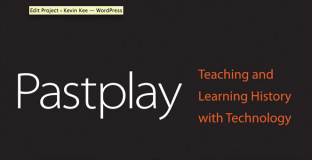“Teaching history in an age of pervasive computing: the case for games”, Canadian Game Studies Association Workshop, Vancouver, September 2008.
In my chapter with Shawn Graham in Pastplay: Teaching and Learning History with Technology (forthcoming from the University of Michigan Press) our focus is games in the university and high school classroom. Over the last decade, the results here have been disappointing. The problem is that we have fundamentally misunderstood how games communicate. We presume that a game that claims to be about ancient Rome will support student learning in a course about ancient Rome. Ignore the promotional material; focus instead on the argument the game’s computer code promotes. To this end, Shawn and I propose a new typology for history games. And we go further: we see the greatest opportunity for teaching history with computer games in “metagaming” — an outside-looking-in awareness of game mechanics. In this “gaming of the game,” students move beyond playing games, or studying games as artefacts, to modifying and even building them for themselves — developing their own representations in computer code.

